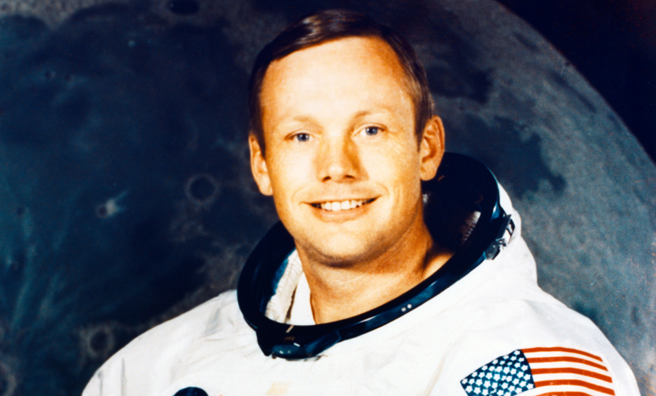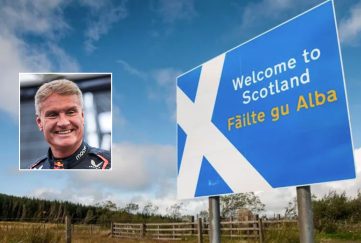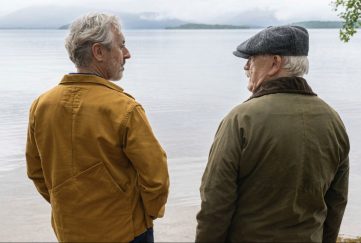Mission To… Langholm?

Neil Armstrong delivered one of the most famous sentences in history 47 years ago… but it seems that the first man on the Moon was almost lost for words the day he came to Langholm.
Fewer than three years after the Apollo 11 Mission made the quietly spoken engineer a legendary figure in space exploration, he was invited to become the first Freeman of Langholm, the area of Scotland which was the stronghold of the Armstrong clan.
“We were really quite surprised when he accepted!”
“We were really quite surprised when he accepted!” says Grace Brown, who still lives in Langholm and being depute town clerk at the time was heavily involved in the preparations for the visit in 1972 and the celebrations on the day itself.
“The town council had made the approach because this is Armstrong country and we thought it would be appropriate. It turned out that he was coming to Edinburgh to deliver the Mountbatten lecture so he could accept and come to Langholm.”
For a man who has been to the Moon, the journey from Edinburgh to Langholm would not have been arduous.
Once the invitation had been accepted, town clerk Eddie Armstrong was head of the organising team – but as Grace explains, there was a steep learning curve ahead for the town of 2500 people.
“We didn’t even know how to do a Freedom ceremony – this was the first. We knew that Hawick had done one, so we asked for advice and they pointed us in the right direction.
“It was an event that everyone wanted to attend”
“Of course, it was an event that everyone wanted to attend but our biggest building at the time was the parish church and that still couldn’t hold everyone who wanted to attend. It was a case of who to leave out – a very difficult decision.”
With nowhere in Langholm that could cater for the numbers involved, an outside catering firm from Edinburgh was employed and a craftsman from near Kirkcudbright was commissioned to create a wooden carving of Johnnie Armstrong’s stronghold, Gilnockie Tower, in which the scroll could be presented.
While Eddie Armstrong visited Neil and his wife in Edinburgh the day before to talk them through the ceremony, Grace was left to deal with a scrum of media that swamped the small town, keen to pick up on the story of the visit.
“There were newspapers from all over the world, particularly from America. I’ll always remember one paper, I think it was the Chicago Tribune, reported it on their front page. They had a map of the British Isles, with only two places highlighted – London and Langholm. We laughed about that for a long time.
“For years after that, Americans were visiting wanting to trace their roots”
“We got a tremendous amount of publicity out of it – for years after that, Americans were visiting wanting to trace their roots.”
Grace’s recollection of the day is still infused with all the excitement that the town must have felt. A local piper had even written a new tune called Commander Neil Armstrong’s Moonstep.
“Neil arrived in Langholm sometime between 10 and 11am. There was bunting everywhere and the pipe bands were out. There was a real festive air.
“He went to the town hall and had a cup of coffee with some of the town council, and when he left to go to the church for the ceremony, we surprised him with a carriage drawn by two grey horses.”
“It makes the hairs stand up on the back of my neck to think about it, even now”
As he entered the church, the organist began to play See The Conquering Hero Come. “It makes the hairs stand up on the back of my neck to think about it, even now,” says Grace.
Neil took the oath of allegiance and his burgess ticket, which Grace also recalls was on white vellum, was presented in the wooden tower.
The short emotional speech in which his voice creaks with emotion can be found online
A recording of the ceremony and the short emotional speech in which his voice creaks, quite clearly, with emotion can be found online.
He then walked from the church to a lunch at the Buccleuch Hall (now the Buccleuch Centre) and even though he was a man of few words, he was keen to meet the people who had lined the streets to see him. He shook hands and signed as many autographs as he could – one is a treasured souvenir of Grace’s, of course.
There was a young boy of around six or seven who stood in the crowd with a sign around his neck saying “My Name Is Neil Armstrong”. Those who organised an exhibition commemorating the links between the town and the astronaut on his death in 2012, tried to trace the boy, but without luck.
“There had been a new tartan commissioned for his visit – the Lunar tartan”
At the lunch, the Armstrongs were presented with a pile of gifts. Particularly relevant to the area of course were lengths of tweed. “There had been a new tartan commissioned for his visit,” adds Grace. “It was called the Lunar tartan and the colours were inspired by those of the Moon – although how they knew what colours those were, I don’t know.” She laughs. ”If they were wrong Neil was too kind to tell us.”
He was taken to Gilnockie Tower, something that allowed him to get back to the root of his Armstrong clan, and then spent the night at Drumlanrig Castle as the guest of the Duke of Buccleuch.
Grace was most impressed by the unassuming man, who had no desire to boast about his achievements and seemed more interested in finding out more about his Armstrong roots and making a connection with the area.
“It was definitely the highlight of my career in the town hall. It’s something none of us who were there that day will ever forget.”
In the clip of Neil Armstrong’s speech following the Freeman award, his genuine delight at the welcome is evident. In it, he says, “The most difficult place to be recognised is in one’s own home town – and I consider this now my home town.” It is done not with fake sincerity or a celebrity grin, but with a quiet dignity.
The visit might have been a small step for Neil, but it was a giant occasion for Langholm.
Neil Armstrong facts
- Neil Armstrong was born in Wapakoneta in Ohio on August 5, 1930.
- He joined NASA’s astronaut program in 1962.
- Armstrong made history on July 20, 1969 by becoming the first man to walk on the Moon.
- The words he spoke on taking his first steps on Moon have gone down in history – “That’s one small step for man, one giant leap for mankind.”
- Armstrong died in Cincinnati, Ohio, in 2012.





